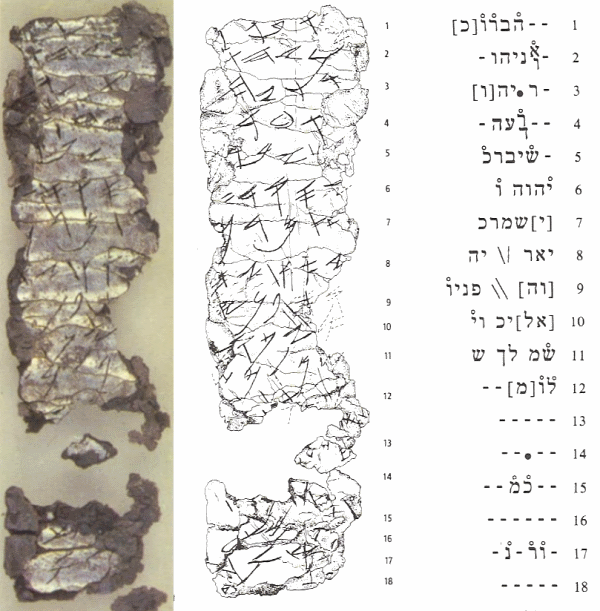Description: A silver scroll with the Aaronic Blessing from the 7th Century B.C. This is the oldest known text of the Hebrew Bible.
Era: Middle Semitic Script
Image Credit: Unknown
Date of Inscription: 7th Century B.C.
Location of Discovery: Ketef Hinnom, Israel
Date of Discovery: 1979
Current Location: ?
Language: Hebrew
Writing Surface: Silver Scroll
Transliteration: TBD
Translation: TBD
Comments: Several seasons of excavation were carried out between 1975 and 1995 on Ketef Hinnom (Hebrew for "shoulder of Hinnom") a hill overlooking the Hinnom Valley, southwest of the Old City of Jerusalem. In the area next to St. Andrew's Church, finds dating from the Iron Age to the Ottoman period were uncovered.
The major discovery of the Ketef Hinnom excavations were several rock-hewn burial caves dating from the end of the First Temple period (7th century BCE), which contained an abundance of small artifacts, though the caves had been plundered and damaged in the past. The burial chambers have wide rock-cut benches, some with a raised headrest, on which bodies were laid. Space hewn beneath the benches served as repositories of bones for secondary burial, making room for burial of other family members.
One of the larger tombs, which probably belonged to a wealthy family, was found almost intact, with over a thousand objects in it: many small pottery vessels; artifacts of iron and bronze including arrowheads, needles and pins; bone and ivory objects; glass bottles; and jewelry, including earrings of gold and silver. The tomb was in use for several generations towards the end of the First Temple period and for some time after the destruction of 587-6 BCE.
The most important of all the objects found in this tomb are two small silver scrolls. They were somewhat damaged - small wonder, since they were placed in the tomb in the 7th century BCE. Carefully unrolled by experts at the Israel Museum laboratories, they were found to be covered with ancient Hebrew script on the obverse, which was deciphered with some difficulty.
The larger of the two plaques measures 97 x 27 mm., the smaller only 39 x 11 mm. The larger plaque contains 18 lines of writing, mostly legible. Both plaques contain benediction formulas in paleo-Hebrew script, almost identical to the biblical Priestly Blessing in Numbers 6:24-26.
This biblical text, dated to the 7th century BCE, is the oldest known to date and pre-dates the texts found in the Dead Sea area by about 500 years. The word yhwh (the name of the Lord in Hebrew) appears in writing for the first time ever. The benediction quoted from the Book of Numbers was recited by the Temple priests when blessing the congregation; here it is found in writing and for individual use. The tiny silver scrolls were probably worn as amulets around the neck.
(Israel Ministry of Foreign Affaris)



